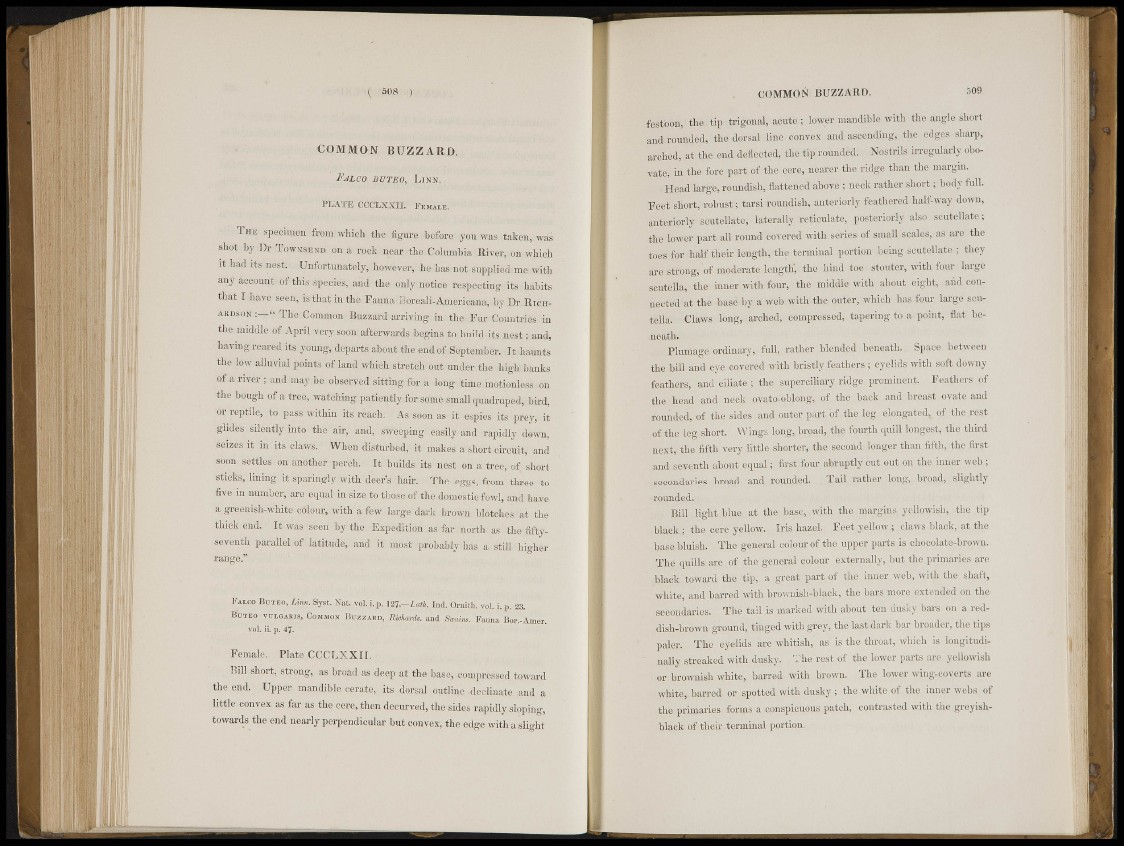
C O M M O N BUZ Z AUL).
M J'JLc:o HCTEO, 1,1 \'N.
1 PÍAIE' oeoisxii:1 i-'KMiiE. •
THE specimen from which the figure -before you was taken, wai
«Bal fey Dr TOWNSBN®, to a rock, neap the Columbia Hiver, on which
it had its -nest. .Unfortunately, however, he has mot supplied îne with
a # account rf.thi¿.species,, and the. Only ^notice respecting its.habits
that I have- seem, is H a t in theiFapn^Soreali-Americana, -by Dr RTCHAADSONI:—"
The.Common Buzzard arriving in the iFüi- Countries in
the Middle of April very soon, afterwards begins to,build its. nest ; and,
having reared its young, departs about the end of. September. It haunts
the low aHwral points |Sland which stretch out under the highftanks
of a river ; and may be observed sitting for a longtime motionless.-on
the bough of a tree, Wattohing patiently, for some, small quadruped, bird,,
or reptile, to pass within its reach, As soon as it espies its prey, it
glides silently into the air, and, swesping easily and rapidly down,
seizes it in its claws. When disturbed, it makes a short circuity-and
soon, settles on another perch: It builds its nest on a tree, of short
sticks, lining it sparingly wi f t deer's hair. The eggs, from three $o
five in number, are equal in size to those of the domestic fowl, and have
a iÇraeniih whitoícSIónr, with a few large dark .brow» iblotches. at .the
thick end. It was'seen .lay the Expédition as'far north-as the fiftyseventh
'parallel of latitude,1 and' it most probably has a still higher
range."
FALCO BUTEO, Unn. Syst.Nat. vol i p. 127.—Zatt I ml Ormtli vol i j, 23
J & T I O TUIGAIUS, 'OOMMOIT lii:zzAni>, Sohai-ds and ÂJIAIW l.',U,IM Bor -Amor.
YoL iifp „47
Femalo. Plat« CCCI.XXII.
Bill short, strong, as broad as deep at the base, compressed' toward
the end. tipper mandible cerate,, its dorsal outline -declínate and a
.little convex âsjfar as the coro, thou doouiwl, the side.« rapidly sloping,
towards the end nearly perpendicular but convex, the edge with a slight
COMMON BUZZARD. 509
festoon, lilt:; tip trigonal, acute.; lower mandible with the angle short
and Bounded, the dorsal lino convex and aseonding,-. the edges sharp,
arched, at. the'ond deflected,, the tip roundèd. Nostrils: irreirularly obotate,
in the £or,e part of the cere, nearer the ridge than the margin.
Head large, roundish, flattened above1 ; nock rather short ; body full.
§'.eet short, robust ? tarsi rounfeh,. .anteriorly feathered halfway dlown,
anteriorly scutellate, laterally reticulate,'posteriorly also scutellate;
the lower part all round .covered with series of small scales, as arc the;
toes for half their length, th.- terminal portion being scutellate ; they
are strong, of moderate length', the bind toe, stouter, with four large
scutella, the inner with four, the middle with about eight, and connected
at the basé l.y a web. with tireouter, which, has four large s cutela.
Claws, long, arched, compressed, tapering to a. point, flat beneath.
Plumage ordinary,, full, rather blended beneath. Space between
the bill aaid! eye covered with bristly feathers.; eyelids with Soft, downy
loath».-!*, and ciliate ; the supon-iiiarv ridge prominent, Feathers of
the head as»l neck ovato-'oblong, of the back and breast ovate and
rounded, of the sides and outer part of the leg .elongated, of the rest
of the leg short. Wings long, broad, .the fourth quill longest, the third
next, the fifth very little shorter, the second longer than fifth, the first
and seventh about equal ; first four abruptly cut ont to the inner web ;
secondaries broad and rounded. Tail rather long, broad, slightly
•rounded.-
Bill light blue, at the base, with the. margins,yellowish, the. tip
blacks the cere yellow. Iris hazel. Koet voiiow ; claws black, at the
base bluish. The general colour of the upper parts is chocolate-brown.
The. quills are of the- general colour externally, but the primaries are
black toward the tip, a great-part of the inner Web,, with the shaft,
white, and barred with brownish-black, the bars more extended on the
secondaries. The tail is marked with about ten dusky bars on a.reddish
biown ground, tinged with grey, the last dark bar broader, the tips
paler. The eyelids are whitish, as" is the throat, which is longitudi-
-, nally streaked with dusky, The rest of the lower parts are yellowish
or brownish white,, barred with brown. The lower wing-coverts are
white, barred or spotted, with dusky ; the white of the inner, webs of
the primaries forms a conspicuous, patch, contrasted with the greyishblack,
of their terminal portion.